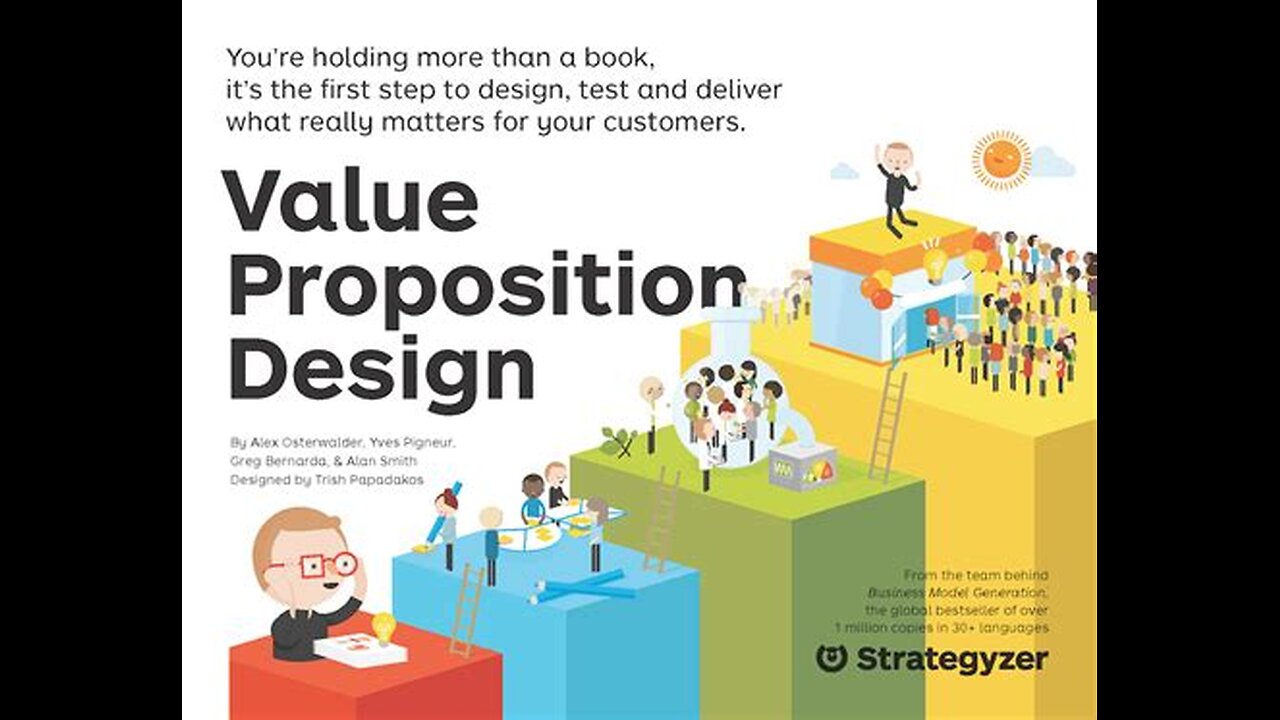Premium Only Content

Value Proposition Design by Alexander Osterwalder ET AL | Summary
Buy Here: https://amzn.to/4j2Ckrv
"""Value Proposition Design"" by Alexander Osterwalder, Yves Pigneur, Gregory Bernarda, and Alan Smith is a book that offers practical guidance and methodologies for creating and refining compelling value propositions for products or services. It focuses on understanding customer needs, designing solutions that address those needs, and effectively communicating the value to customers.
Key themes and concepts covered in the book include:
1. Value Proposition Canvas: The authors introduce the Value Proposition Canvas, which is a visual tool that helps entrepreneurs and product managers map out and analyze the value they create for customers. It consists of two components: the Customer Profile, which identifies the specific jobs, pains, and gains of the target customers, and the Value Map, which describes the products, services, and features that alleviate customer pains and create gains.
2. Customer Discovery: The book emphasizes the importance of customer discovery and gaining a deep understanding of customers' needs, challenges, and aspirations. It provides techniques for conducting customer interviews, observation, and other research methods to gather insights and validate assumptions. This customer-centric approach ensures that value propositions are tailored to meet real customer demands.
3. Value Creation and Differentiation: The authors guide readers through the process of creating unique value propositions that stand out in the market. They explore methods for identifying customer pain points, designing features and benefits that address those pains, and creating gains that exceed customer expectations. The book also addresses the concept of differentiation and how to position value propositions in a way that distinguishes them from competitors.
4. Prototyping and Testing: ""Value Proposition Design"" encourages a rapid prototyping and testing approach to validate value propositions. It advocates for creating minimal viable products or prototypes to gather customer feedback and iterate on the value proposition. The authors provide techniques for conducting experiments and gathering data to inform decision-making and improve the value proposition over time.
5. Communication and Visual Design: The book emphasizes the importance of effectively communicating the value proposition to customers. It provides guidance on using visual design and storytelling techniques to convey the value proposition in a compelling and engaging manner. The authors also address channels and touchpoints where the value proposition can be effectively communicated to the target audience.
6. Iterative Process: The book promotes an iterative and continuous improvement mindset in value proposition design. It encourages entrepreneurs and product managers to constantly test, learn, and adapt their value propositions based on customer feedback and market insights. This iterative approach helps to refine and enhance the value proposition over time.
""Value Proposition Design"" is a practical guide for entrepreneurs, product managers, and business professionals who want to create compelling value propositions that resonate with customers. By applying the concepts and methodologies in the book, readers can better understand customer needs, design solutions that address those needs, and effectively communicate the value proposition. It offers a systematic and customer-centric approach to developing and refining value propositions to increase the chances of success in the market."
-
 LIVE
LIVE
SpartakusLIVE
9 hours agoMega SOLO Spartan Stream - 12 hours?! HA || Variety Later?!
1,655 watching -
 LIVE
LIVE
Rallied
2 hours ago $0.08 earnedSolo Warzone Challenges All Night
1,055 watching -

Due Dissidence
11 hours agoTaibbi DEFENDS Weiss-CBS Deal, Pakman Producer SPILLS TEA, Massie CALLS OUT Trump Informant Claims
13.5K26 -
 2:33:47
2:33:47
TheSaltyCracker
4 hours agoMedia Silent on Metro Attack ReeEEStream 9-07-25
116K198 -
 56:27
56:27
Sarah Westall
5 hours agoEnd of Aging, Hydrogen Bomb Research, Serial Killers & Violent Behavior, Bipolar Research w/Dr Walsh
23.5K2 -
 4:36:53
4:36:53
MattMorseTV
6 hours ago $0.46 earned🔴Sunday Gaming🔴
49.2K2 -
 2:31:16
2:31:16
Joker Effect
3 hours agoINTERVIEWING Rumble Gaming community members: Viewbotting and how they see the current landscape.
13.1K2 -
 1:45:53
1:45:53
Nerdrotic
6 hours ago $0.27 earnedUnravelling the Secrets of Skinwalker Ranch | Forbidden Frontier #115
71.8K4 -
 41:56
41:56
Athlete & Artist Show
6 hours ago $0.75 earnedAustin Ekeler: Going From "0 Star Recruit" To Leading The NFL In TD's, New Fan App | FROM THE VAULT
21.7K1 -
 2:46:49
2:46:49
Barry Cunningham
11 hours agoNOW THEY FEAR US! | RFKJR STRIKES BACK | JD VANCE ON PRESIDENT TRUMP | AND MORE NEWS!
67.2K49